NVIDIA GeForce GTX 760 Review: The New Enthusiast Kepler
by Ryan Smith on June 25, 2013 9:00 AM ESTSleeping Dogs
Another Square Enix game, Sleeping Dogs is one of the few open world games to be released with any kind of benchmark, giving us a unique opportunity to benchmark an open world game. Like most console ports, Sleeping Dogs’ base assets are not extremely demanding, but it makes up for it with its interesting anti-aliasing implementation, a mix of FXAA and SSAA that at its highest settings does an impeccable job of removing jaggies. However by effectively rendering the game world multiple times over, it can also require a very powerful video card to drive these high AA modes.
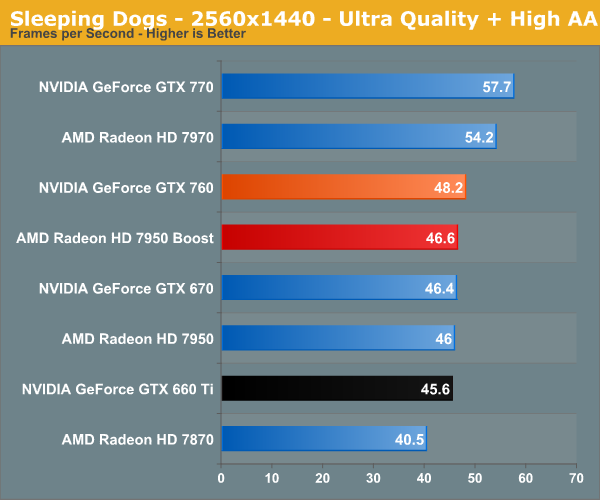
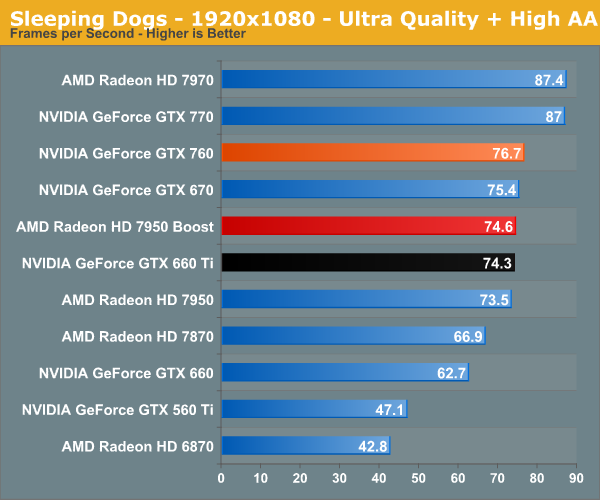
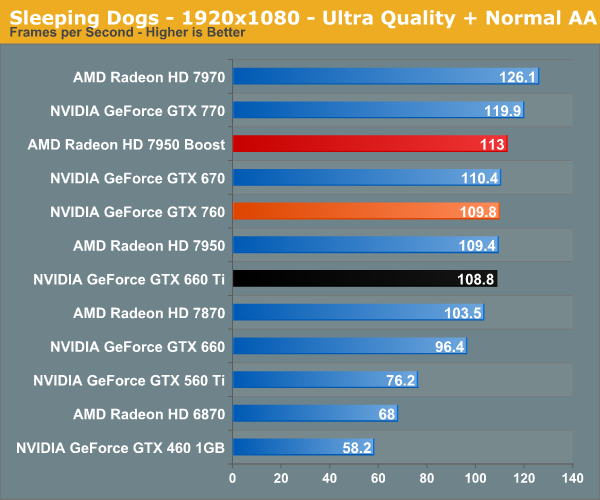
With Sleeping Dogs the GTX 760 is once again back on top, although this time it’s a close fight between it and the 7950B. In this case the gap at our higher 1080p settings is just 3%, nearly a tie. Meanwhile it’s interesting to see the GTX 760 doing so well compared to the GTX 670 here, even beating it just slightly. The use of SSAA hits the ROPs and shaders pretty hard, so while we’d typically expect the GTX 760 to fall behind the GTX 670 here, this appears to be a case where the higher core clockspeed and resulting higher ROP performance works in the GTX 760’s favor.
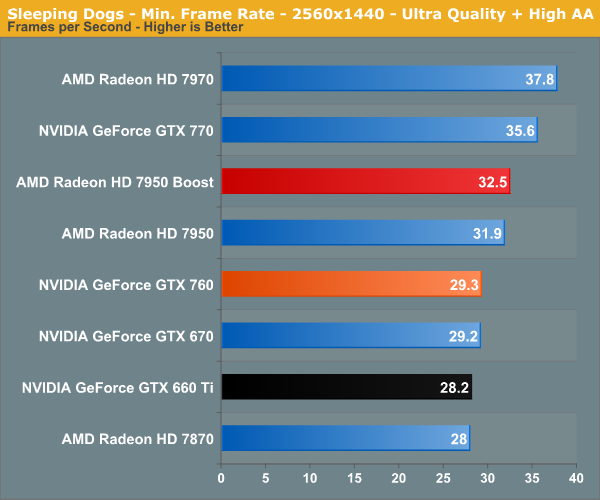
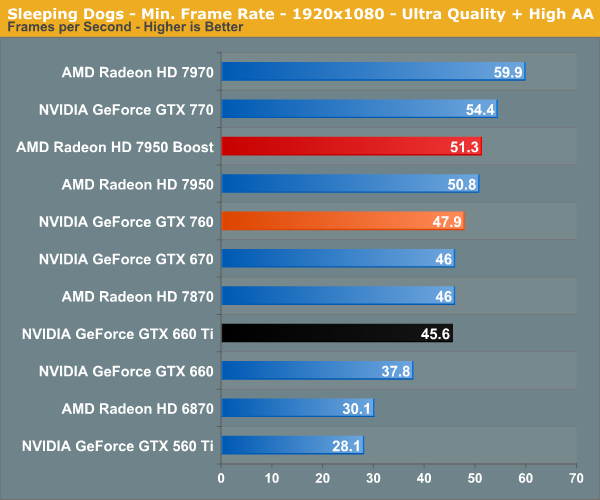
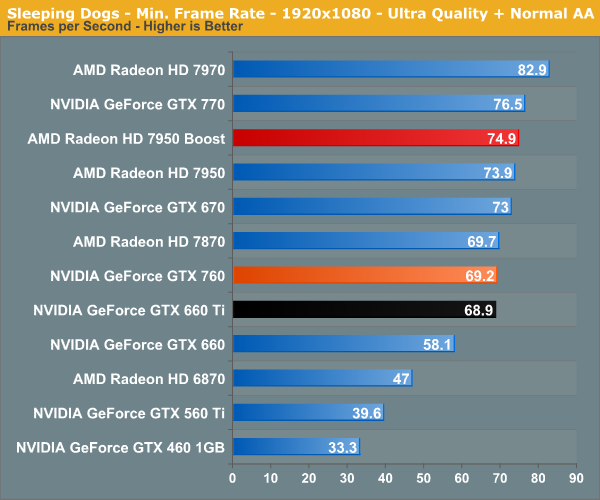
With our minimum framerates however the GTX 760 falls behind the 7950B. Here AMD’s competitor performs about 7% better at our highest 1080p settings, keeping AMD’s card above 50fps.










110 Comments
View All Comments
Ryan Smith - Tuesday, June 25, 2013 - link
Going by my chart, I have the GTX 760 winning in 7 of 10 games (all but DiRT, Hitman, and Crysis 1) at our highest 1080p quality settings, which is where I'm focusing on for a card this expensive. Of those magnitude matters; most of those GTX 760 wins are in the double digits, so the average does indeed end up being 8%As for frametimes, the idea is that we would normally include them. That said this review left us crunched for time; I would have likely needed to drop the Fermi cards to make time. With that in mind, there's absolutely nothing interesting going on with single-GPU frametimes right now with the games we use. The only place NVIDIA still differ are under multi-GPU scenarios.
Zstream - Tuesday, June 25, 2013 - link
Shouldn't we be using the median instead of average?ewood - Tuesday, June 25, 2013 - link
median, mean and mode all show very different things. you should have all three to draw detailed conclusions, however if only one is available i would personally prefer it be the mean.ShieTar - Thursday, June 27, 2013 - link
With a sample size of 10, the median would not be a very helpful information. To be honest, the mean is not all the important either. The distribution of performances is not all that random when comparing nVidia and AMD, but rather there are significant preferences for one architecture by each game.So everybody on the lookout for a new card should mainly be checking for a benchmark specifically on the game he/she spends the most time with. For this reason, I would love to see the benchmarks on Anandtech include the name of the engine for each game (if it is a licensed one), and maybe provide some handy reference to figure out what other games use the same reference.
And personally, as a player who does not play reaction-based games like shooters or racers a lot, I would love AT to re-introduce a BioWare and/or Blizzard title back into their benchmark-zoo. Even if those are not extremely new or demanding, I think they still have a high importance for a large number of players who don't care much to shoot virtual people in their virtual faces.
MarcVenice - Tuesday, June 25, 2013 - link
I see, I counted Sleeping Dogs as a win for the HD 7950 as well, considering the minimum fps is a bit higher. Thanks for the reply, I agree that if all is well with frametimes in a certain game, fraps is still a good way to measure raw rendering power.JeBarr - Tuesday, June 25, 2013 - link
Most multi-GPU users are reporting that the frame time issue mostly exists for 2-way SLI and Quad SLI. It seems that 3-way SLI or Dual GPU single slot SLI is the way to go for gamers concerned about the stutters. I'm not sure about 4-way SLI though, since I don't bother with it anymore. I can however, confirm that in my personal experience a single GPU or 3-way SLI is mostly unaffected.draknon - Tuesday, June 25, 2013 - link
This seems like a good spot to upgrade from my 460gtxEzioAs - Tuesday, June 25, 2013 - link
Yeah, it is. My original plan was to get the GTX 760, but Nvidia delayed it and I wasn't going to wait anymore, so I went and bought the GTX 660.DanNeely - Tuesday, June 25, 2013 - link
I'm tempted to upgrade to it from my 560 when I built a Haswell box later this summer and put the difference between it and a higher end card toward a better SSD, etc and then get a top end Maxwell based card next year.I'm a bit concerned about ending up in the same trap I did last time though. I bought the 560 as a stopgap replacement in Jan 2012 after stupidity killed my 5870, with the intent of upgrading to a GK100 based card in half a year or so only to have nVidia fumble its top end launch.
omarccx - Tuesday, June 25, 2013 - link
It seems like an even greater upgrade from my HD4000. :x